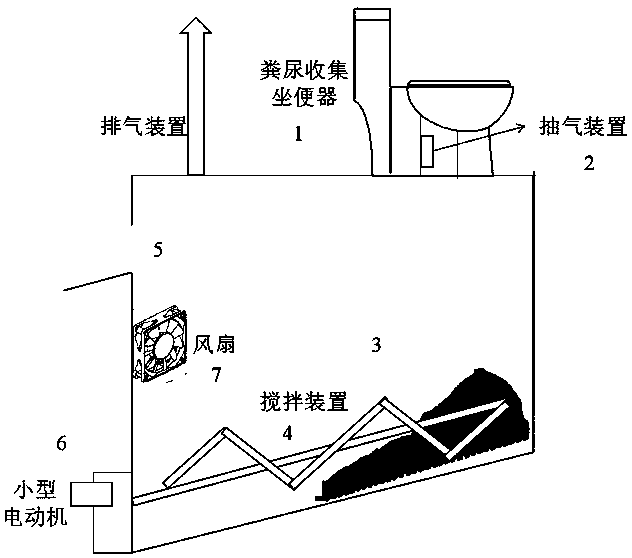Flushing-free ecological toilet taking coconut shell crumbs as biological matrix
A coconut shell, water-free flushing technology is applied in the treatment of biological organic parts, fertilizers made of biological waste, sanitary equipment, etc. The effect of reducing resources, reducing waste, and reducing environmental pollution
- Summary
- Abstract
- Description
- Claims
- Application Information
AI Technical Summary
Problems solved by technology
Method used
Image
Examples
Embodiment 1
[0024] The mixed substrate of feces and coconut husks contains easily degradable, non-degradable and non-degradable organic matter. The degradation process of the ecological toilet is to use microorganisms to decompose and transform the degradable organic matter in the raw materials to generate CO 2 , water and heat process. Therefore, the reduction of organic matter is a direct indicator of the fermentation process. In the 33rd day, the residue of the substrate in the slope reaction tank was taken to test the organic matter content, and the test results were as follows: image 3 shown. The results showed that the organic matter content continued to decrease during the 33-day period, and finally stabilized at about 35.1%, indicating that the coconut shell shavings-based ecological toilet works well.
Embodiment 2
[0026] The carbon-nitrogen ratio of compost is an important chemical index to evaluate the degree of composting. During the composting process, microorganisms consume carbohydrates continuously, so the carbon-nitrogen ratio tends to decrease, because the carbon-nitrogen ratio of microorganisms is about 16. Theoretically, the decomposed compost should eventually tend to have a microbial cell carbon-to-nitrogen ratio of about 16. In order to investigate the change of carbon-nitrogen ratio in the non-water flushing ecological toilet with coconut shell chips as the biomass base, the substrate residues in the slope reaction tank were taken on 1, 5, 9, 13, 17, 21, 25, 29, and 33 days Carry out the carbon-nitrogen ratio test, the test results are as follows Figure 4 As shown, the final carbon-nitrogen ratio is about 14.2%.
PUM
| Property | Measurement | Unit |
|---|---|---|
| particle diameter | aaaaa | aaaaa |
Abstract
Description
Claims
Application Information
 Login to View More
Login to View More - R&D
- Intellectual Property
- Life Sciences
- Materials
- Tech Scout
- Unparalleled Data Quality
- Higher Quality Content
- 60% Fewer Hallucinations
Browse by: Latest US Patents, China's latest patents, Technical Efficacy Thesaurus, Application Domain, Technology Topic, Popular Technical Reports.
© 2025 PatSnap. All rights reserved.Legal|Privacy policy|Modern Slavery Act Transparency Statement|Sitemap|About US| Contact US: help@patsnap.com



